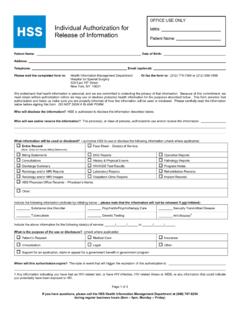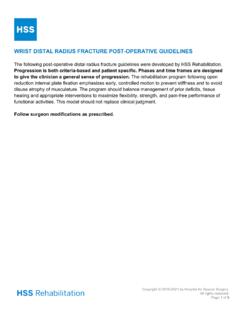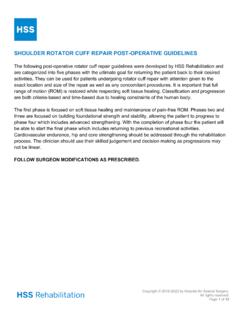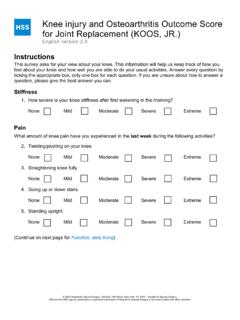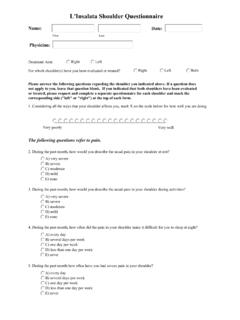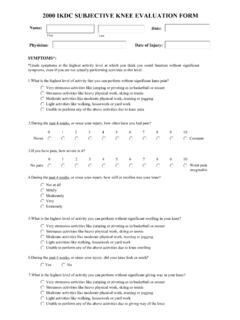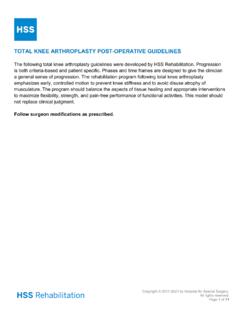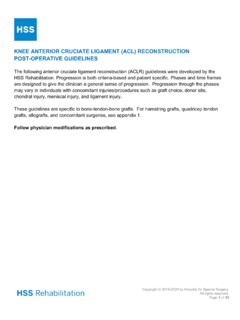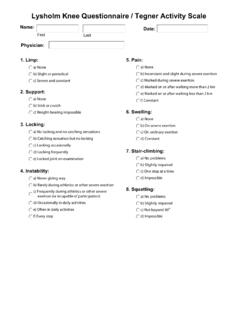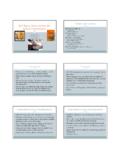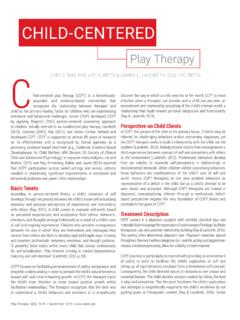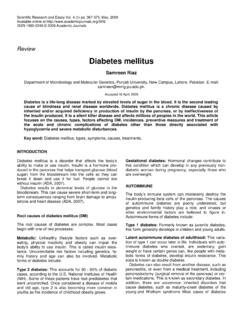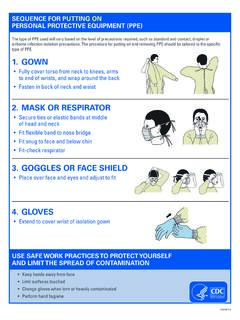Transcription of Knee MCL Sprain Non-Operative Guidelines
1 Copyright 2020-2022 by Hospital for Special Surgery. All rights reserved. Page 1 of 12 KNEE MEDIAL COLLATERAL LIGAMENT (MCL) Sprain Non-Operative Guidelines The following Guidelines for the Non-Operative management of medial collateral ligament (MCL) sprains of the knee were developed by HSS Rehabilitation. They are divided into four phases dependent on patient presentation and grade of the Sprain (grade 1-3). Progression is both criteria based and patient specific. The rehabilitation program initially emphasizes reduction of pain and swelling while not overstressing the involved tissue and progresses to restoration of stability and functional activity in later phases. Timing for advancement through the phases varies depending on the severity of the Sprain and concomitant injuries, if present.
2 Additionally, progression through the phases should be in alignment with patient goals. Grades of Sprain Grade 1 sprains involve a minimal number of fibers torn with localized tenderness and no laxity. These sprains typically present with full or near full range of motion (ROM), with little or no swelling or accompanying quadriceps inhibition. Athletes with grade 1 sprains usually progress quickly and return to contact sports in 1-2 weeks with physician clearance. Grade 2 sprains involve a greater degree of ligamentous disruption with slight to moderate laxity and require an element of protection (weight bearing precautions). Grade 2 sprains in athletes typically result in 2-4 weeks of rehabilitation and return to contact sports wearing a brace if the sport allows.
3 Grade 3 sprains involve a complete tear of the ligament with disruption of fibers and demonstrable laxity. Grade 3 sprains require protection and are usually season ending with a 8+ week course of rehabilitation required. Follow referring provider s modifications and brace Guidelines as prescribed. Copyright 2020-2022 by Hospital for Special Surgery. All rights reserved. Page 2 of 12 KNEE MCL Sprain Non-Operative Guidelines Phase 1: Weeks 0-2 (up to 4 weeks if grade 3 Sprain ) PRECAUTIONS Screen for fractures with Ottawa Knee Rules Assess for injury to supporting structures o Anterior cruciate ligament o Posterior cruciate ligament o Medial and lateral meniscus o Patella instability in grade 2-3 sprains Avoid exercises and activities that increase pain and/or swelling Avoid end range stretching if empty end feel is present Weight bearing (WB) precautions and bracing as prescribed by referring provider (grades 2 and 3) CONSIDERATIONS Know grade of Sprain and tissues involved Grade 1 sprains typically progress more quickly than time frames noted in guideline ASSESSMENT Lower Extremity Functional Scale (LEFS)
4 Pediatric International Knee Documentation Committee Subjective Knee Evaluation Form (Pedi-IKDC) validated for ages 10 -18 years Numeric Pain Rating Scale (NPRS) Edema measurements Neurovascular assessment Palpation of pain generators Lower extremity (LE) active range of motion (AROM) and passive range of motion (PROM) LE flexibility, where appropriate LE strength, where appropriate Patellar mobility and apprehension Special tests for ligamentous laxity and irritability Quality of quadriceps contraction: good, fair, poor Straight leg raise (SLR) in supine: with or without lag Gait: with/without assistive device Prior/current level of function Copyright 2020-2022 by Hospital for Special Surgery.
5 All rights reserved. Page 3 of 12 TREATMENT RECOMMENDATIONS Patient education o Understanding valgus stress on the knee o Activity modifications to decrease or eliminate pain and swelling o Understanding the importance of compliance with the home exercise program (HEP) o Management of pain and effusion Functional training o Gait Follow referring provider s prescribed brace and WB instructions, typically: Grade 1: weight bearing as tolerated (WBAT) Grade 2-3: protected WB as per referring provider s instructions Progressively wean off assistive device based on referring provider s recommendation and gait normalization (will take longer for grade 3 Sprain ) Aquatic therapy or antigravity treadmill if available o Stairs Progress from non-reciprocal to reciprocal stair negotiation as tolerated and per referring provider s instructions o Weight shifting while adhering to WB precautions, if any Flat, static surface Progress to uneven surfaces Edema management o Protect, optimal loading, ice, compression, elevation (POLICE)
6 O Modalities Manual therapy o Joint mobilizations Patella mobilizations in all planes if appropriate o Soft tissue mobilization (STM) Myofascial release Edema control ROM/flexibility o Active assisted range of motion (AAROM) and AROM exercises (if braced, may remove or unlock unless not permitted by referring provider) o Stretching o Foam rolling o Stationary bike o Aquatic therapy if available Neuromuscular electric stimulation (NMES) quadriceps Strengthening o Progressive resistance exercises (PREs) Consider blood flow restriction (BFR) with low demand exercises with FDA approved device and qualified therapist Quadriceps sets Copyright 2020-2022 by Hospital for Special Surgery.
7 All rights reserved. Page 4 of 12 SLR all planes o Lock brace at 0 if there is a quadriceps lag o Grade 1: hip adductors when no pain (delay for grades 2 and 3) Terminal Knee Extension (TKE) o Consider weight bearing status o If no pain at end range extension LE stabilizers proximal/distal to the knee, as tolerated o Upper Extremity (UE) and core strengthening No limits on UE or core workouts that do not affect the injured knee CRITERIA FOR ADVANCEMENT Minimal to no swelling present Improved knee ROM o Full knee extension o 110 knee flexion SLR without quadriceps lag Normalized gait mechanics with appropriate assistive device, if appropriate EMPHASIZE Pain-free exercises Edema management Limit activities that stress healing tissues Avoid valgus stress Normalize gait Copyright 2020-2022 by Hospital for Special Surgery.
8 All rights reserved. Page 5 of 12 KNEE MCL Sprain Non-Operative Guidelines Phase 2: Weeks 3-6 (up to 8 weeks if grade 3 Sprain ) PRECAUTIONS Avoid premature return to activity Avoid stretching or overloading the injured ligament ASSESSMENT LEFS Pedi-IKDC NPRS Edema measurements Patellar mobility Quality of quadriceps contraction: good, fair, poor LE AROM and PROM LE flexibility LE strength, handheld dynamometry preferred (HHD) Gait without assistive device (if cleared by referring provider) Functional assessment o Squat: bilateral o Single leg balance o Forward step up TREATMENT RECOMMENDATIONS Patient education o Progressive activity modification based on pain o Reinforce compliance with HEP o Movement strategies (importance of hip strategy versus knee strategy) o Edema management: POLICE, modalities Manual therapy o Joint mobility Patella all planes Tibiofemoral anterior/posterior o STM as needed ROM/Flexibility o Achieve full and painless knee AROM o Stretching o Foam rolling Copyright 2020-2022 by Hospital for Special Surgery.
9 All rights reserved. Page 6 of 12 Strength o PRE for quadriceps, hamstrings, hip abductors/adductors (Grade 3: hold isolated adductor strengthening until weeks 4-6) o Emphasize closed kinetic chain exercises </= 90 knee flexion TKE Wall Sits Static lunges Leg press: double leg eccentric single leg Avoid hyperextension o Open kinetic chain quadriceps strengthening isometrics progressing to limited arc isotonics o UE and core strengthening No limits on UE or core workouts that do not affect the injured knee Balance and proprioception, while adhering to WB precautions o Progress from double limb to single leg balance Stable surfaces unstable surfaces eyes closed Add opposite LE movement Functional training o Gait.
10 Retrograde treadmill, antigravity treadmill o Squat emphasizing hip strategy Bilateral to chair, progress depth as tolerated to 90 o Forward step ups (FSU) Progress from 4-6-8 inch ( ) step o Forward step downs (FSD) Progress from 4-6 step Cardiovascular o Stationary bicycle o Elliptical CRITERIA FOR ADVANCEMENT Full knee ROM Pain and edema managed as activity increases 80% or greater quadriceps strength compared to contralateral leg with HHD Able to perform symmetrical squat with proper alignment and control Able to perform single leg balance without compensation Able to perform pain-free FSU 8 and FSD 6 with proper alignment and control Copyright 2020-2022 by Hospital for Special Surgery.
